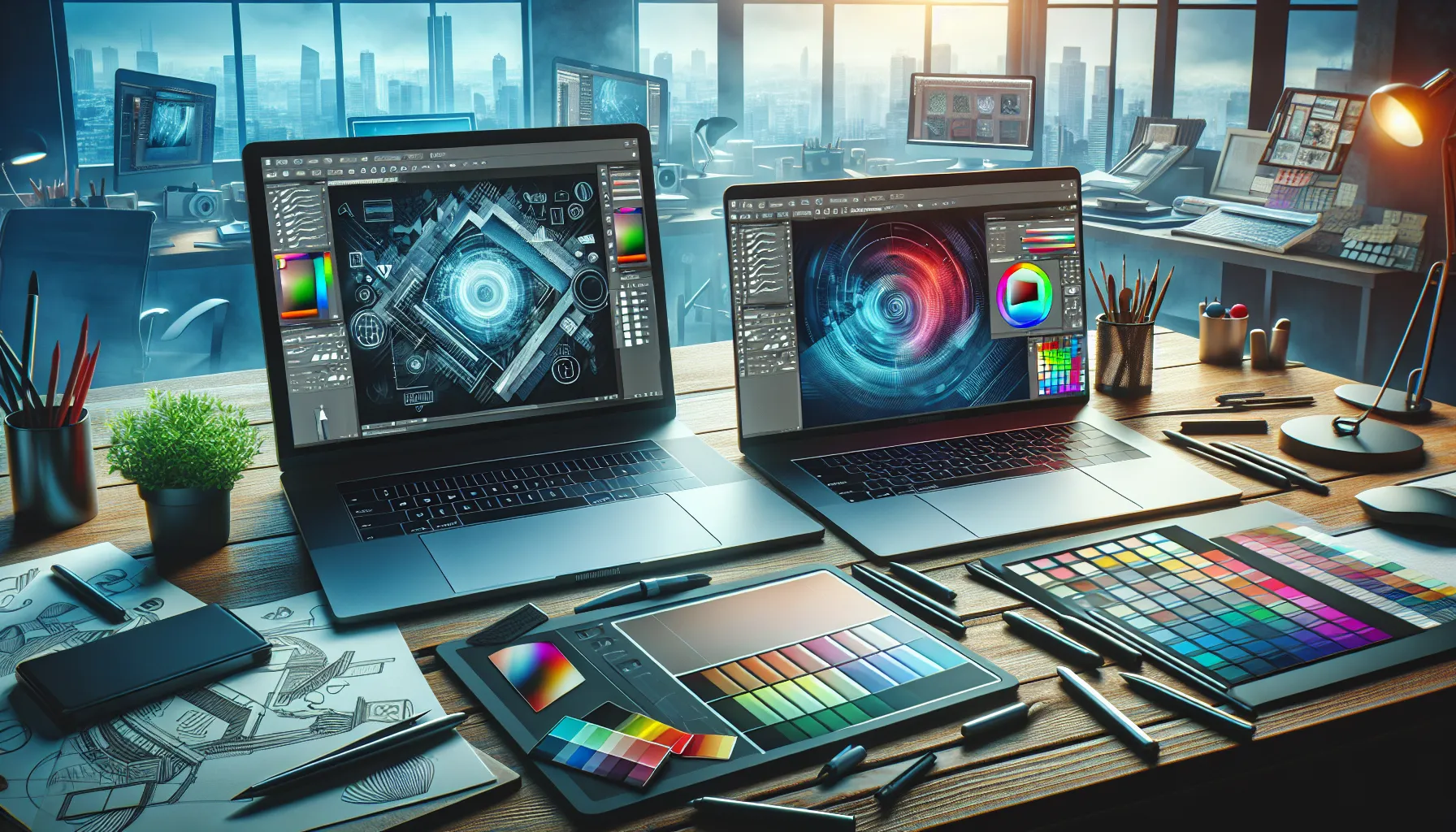Key Takeaways
- Affinity Designer is cost-effective with a one-time purchase model, making it ideal for freelancers, hobbyists, and budget-conscious users.
- Adobe Illustrator offers advanced features like AI tools, precise controls, and seamless Creative Cloud integration, catering to professionals handling complex projects.
- Affinity Designer provides ease of use with an intuitive interface and combined vector/raster tools, perfect for beginners and independent creatives.
- Illustrator excels in compatibility, supporting a wide range of file formats and ensuring smooth collaboration across industries and platforms.
- Your choice depends on priorities: Affinity Designer emphasizes affordability and simplicity, while Illustrator shines in versatility, scalability, and collaborative features.
Choosing the right design software can feel overwhelming, especially when two heavyweights like Affinity Designer and Adobe Illustrator dominate the scene. I’ve spent countless hours exploring both, and I know how tricky it can be to decide which one suits your needs best. Whether you’re a seasoned pro or just starting out, the decision often boils down to features, budget, and personal workflow preferences.
Affinity Designer has gained a strong following for its affordability and impressive capabilities, while Illustrator remains a long-standing industry favorite with its powerful tools and versatility. Both have their strengths and quirks, and understanding what sets them apart can save you time, money, and frustration. Let’s dive into what makes each of these tools unique so you can pick the one that’s perfect for your creative journey.
Overview Of Affinity Designer And Illustrator
Affinity Designer and Adobe Illustrator are two leading graphic design tools offering distinct experiences. I’ve explored both and found that each stands out for its unique approach to design.
History And Popularity
Affinity Designer, developed by Serif in 2014, quickly gained popularity among designers seeking an affordable yet professional alternative to Adobe products. Its one-time payment model attracted freelancers and small business owners.
Adobe Illustrator, part of Adobe’s Creative Cloud suite, has been a market leader since its release in 1987. It’s widely used by professionals in industries like marketing, animation, and product design due to its long-standing reputation and advanced capabilities.
Key Features And Tools
Affinity Designer delivers a dual-environment system, combining vector and raster tools in one app for seamless design workflows. It supports artboards, customizable grids, and live adjustments, making complex designs manageable. Its efficient performance and cost-effective pricing enhance its appeal.
Adobe Illustrator boasts sophisticated vector tools, cloud integration, and AI-enhanced features like content-aware cropping. With support for unlimited artboards, precise typography tools, and advanced brushes, it remains a preferred choice for creating professional-quality illustrations, logos, and scalable graphics.
User Interface Comparison

Understanding the user interface of design software helps evaluate its efficiency and ease of use. Both Affinity Designer and Adobe Illustrator offer distinct experiences tailored to different preferences.
Layout And Design
Affinity Designer presents a clean, minimalist interface, reducing distractions and prioritizing functionality. Its Persona toolbar simplifies workflows by dividing tasks into vector and raster environments. This separation improves focus and provides access to relevant tools without unnecessary clutter.
Adobe Illustrator features a more traditional, complex interface with numerous panels and options. While the layout may appear overwhelming initially, it’s designed for flexibility. Users can dock, rearrange, or hide panels to suit specific project needs, catering to detailed and advanced tasks.
Customization Options
Affinity Designer includes essential customization options like adjustable toolbars, personalized color schemes, and scalable workspaces. These basic settings ensure a streamlined design experience, especially for newcomers.
Adobe Illustrator surpasses this by offering extensive customization, including custom keyboard shortcuts, personalized workspace setups, and advanced panel configurations. These options are ideal for professionals managing diverse and intricate project requirements.
Performance And Usability

When weighing Affinity Designer against Adobe Illustrator, performance and usability play a significant role in deciding which software suits specific creative workflows. Let’s dive into how they differ in terms of speed and user adaptability.
Speed And Efficiency
Affinity Designer operates swiftly, even on systems with moderate specifications, by optimizing resource usage. Features like smooth zooming and panning provide a responsive design experience, particularly with complex documents. It uses a single-payment model without cloud dependency, which reduces potential lag from syncing processes.
Adobe Illustrator, on the other hand, benefits from hardware acceleration and offers robust handling for large-scale projects. Its integration with the Creative Cloud boosts collaboration speed for teams, but this reliance can introduce latency during cloud syncing. Illustrator’s advanced features sometimes require more system resources, impacting slower machines.
Learning Curve For Beginners
Affinity Designer offers an intuitive interface ideal for newcomers. Tools are logically arranged, and the Persona toolbar reduces complexity by separating raster and vector editing into distinct modes. Many first-time designers find it easier to grasp due to its minimalistic layout and concise tutorial options.
Adobe Illustrator presents a steeper learning curve. Its extensive toolset demands time for mastery, with customizable workspaces creating additional learning hurdles for beginners. However, detailed official guides, tutorials, and a larger community provide ample support for those starting out.
Pricing And Affordability

When comparing Affinity Designer and Adobe Illustrator, understanding their cost structure is essential. Each software offers different pricing models, catering to varied budgets and user needs.
Subscription Costs
Adobe Illustrator operates on a subscription-based model as part of Adobe’s Creative Cloud. Its monthly plan costs $20.99 for Illustrator alone or $54.99 for the entire Creative Cloud suite, as of October 2023. While this grants access to frequent updates, advanced features, and cloud storage, the recurring payments can add up over time. For professionals working across multiple Adobe apps, this subscription offers value, but it might not suit occasional users.
Affinity Designer, on the other hand, does not use a subscription model, eliminating ongoing fees. This absence of recurring costs makes it more appealing to those on a budget or seeking a simpler payment structure, though it may lack certain advanced subscription benefits like cloud-based collaboration.
One-Time Purchase Options
Affinity Designer provides a one-time purchase option. The desktop version costs $69.99, while the iPad version costs $19.99. This single payment grants lifetime access to the software, including minor updates. It’s an affordable choice for individual users, small teams, or freelancers looking for high-quality design tools without long-term financial commitments.
Adobe Illustrator doesn’t offer a one-time purchase. Users must enroll in a subscription, which means there’s no upfront, one-time payment option for lifetime software usage. While this ensures users always have the latest version, it omits a cost-effective route for those prioritizing affordability over constant updates.
Compatibility And Integration
Compatibility plays a crucial role when selecting design software. Both Affinity Designer and Adobe Illustrator offer tools to ensure seamless workflows, but their approaches differ in key areas.
File Format Support
Adobe Illustrator supports a wide range of file formats, including AI, EPS, PDF, SVG, DXF, and PSD, which makes it versatile for collaborating across industries. It maintains high compatibility with other Creative Cloud applications, making file transfers straightforward. For example, editing layered PSD files is easier in Illustrator since it preserves layers and effects.
Affinity Designer also supports common formats like EPS, PDF, SVG, PSD, and AI but with limitations. While it can open AI files, it converts them to editable content, which may result in layout shifts for complex designs. Its native format (.afdesign) isn’t widely compatible with other applications, which might require exporting to standard formats like PDF or SVG for external use.
Cross-Platform Functionality
Adobe Illustrator works across Windows and macOS and integrates smoothly with Adobe’s mobile apps like Illustrator on iPad, enabling designers to work on projects anywhere. Creative Cloud sync features allow real-time access to files on multiple devices, simplifying collaborations.
Affinity Designer is also available on Windows, macOS, and iPad, offering consistent performance on all platforms. Its iPad app provides full functionality, mirroring the desktop version for a professional experience. However, without cloud integration, files must be manually transferred, which can slow down collaborative processes.
Pros And Cons Of Each Software
Affinity Designer and Adobe Illustrator each shine in specific areas. Understanding their strengths and weaknesses helps in selecting the right tool for different creative needs.
Affinity Designer Strengths And Weaknesses
Affinity Designer stands out for its affordability and intuitive interface. Its one-time payment option eliminates the financial strain of recurring subscriptions. The dual-environment system, combining vector and raster tools, simplifies complex workflows, particularly for projects blending illustrations and pixel-based designs. This adaptability suits freelancers or small teams with limited budgets.
However, it struggles with advanced file compatibility. While it supports common formats like SVG and PSD, converting AI files causes layout shifts and makes cross-software collaboration less efficient. Its lack of cloud integration also adds manual steps for file sharing.
Illustrator Strengths And Weaknesses
Adobe Illustrator is unmatched in its versatility and professional-grade features. Its advanced toolset, AI enhancements, and seamless Creative Cloud integration facilitate collaboration and ensure constant access to the latest updates. The software supports extensive file formats, including AI and EPS, which are essential for high-standard industry projects.
This sophistication comes with drawbacks. The subscription-based pricing makes it costly over time, and the extensive tools create a steep learning curve for new users. Though powerful, its cloud dependency can occasionally lead to latency during large design tasks on moderate systems.
Target Audience
Understanding the target audience for Affinity Designer and Adobe Illustrator helps determine which software suits specific needs and preferences.
Who Should Choose Affinity Designer
Affinity Designer appeals to cost-conscious individuals and small teams. Its one-time purchase model eliminates recurring expenses, making it ideal for freelancers, hobbyists, and small business owners managing tight budgets. The straightforward interface and combined vector/raster tools are beginner-friendly, supporting users who need to switch between tasks seamlessly without navigating advanced customizations.
For those focusing on digital illustrations, branding, or social media designs, Affinity Designer provides robust features for quality output. It works well for creatives who prefer quick, responsive performance, as it doesn’t heavily rely on high-end hardware or cloud-based integration. Designers who frequently work offline or value independent file management will also find it a practical solution.
Who Should Choose Illustrator
Adobe Illustrator suits professionals who demand versatility and high-end capabilities. Its extensive toolset, AI features, and integration with other Adobe Creative Cloud apps benefit graphic designers, illustrators, and marketers in industries like publishing, advertising, and digital media. The subscription ensures access to the latest updates, appealing to users managing complex projects or requiring cutting-edge tools.
Illustrator’s scalability and advanced options, such as precise anchor point control and custom workspaces, support detailed design tasks like typography and UI/UX layouts. Collaborators in team environments may find its cloud connectivity and cross-platform integration critical for efficient workflows. Additionally, users handling various file formats and cross-compatible projects will appreciate its comprehensive compatibility range.
Conclusion
Choosing between Affinity Designer and Adobe Illustrator ultimately comes down to your specific needs and priorities. Both tools offer incredible potential, but their strengths cater to different audiences. Whether you’re drawn to Affinity Designer’s affordability and simplicity or Illustrator’s advanced features and industry-standard reputation, the right choice is the one that aligns with your workflow and budget.
Take the time to explore both options if possible, and don’t be afraid to experiment. The best tool is the one that empowers your creativity and helps you bring your ideas to life.
Frequently Asked Questions
1. Which is better: Affinity Designer or Adobe Illustrator?
Both are excellent design tools, but your choice depends on your needs. Affinity Designer is budget-friendly with strong vector and raster tools, ideal for beginners and freelancers. Adobe Illustrator is more suitable for professionals with advanced features, better integration, and flexibility, though at a higher cost due to its subscription model.
2. Is Affinity Designer good for beginners?
Yes, Affinity Designer has an intuitive interface and a logical tool arrangement that simplifies workflows. It’s beginner-friendly yet powerful enough for creative projects, making it a great option for new designers.
3. Why is Adobe Illustrator better for professionals?
Adobe Illustrator offers advanced tools, extensive file format compatibility, and seamless integration with other Adobe Creative Cloud apps. Its scalability and versatility make it perfect for detailed, high-end design projects.
4. Which software is more affordable?
Affinity Designer is more affordable, with a one-time purchase cost of $69.99 for desktop and $19.99 for iPad. Adobe Illustrator operates on a subscription model starting at $20.99 per month, which can be more expensive over time.
5. Can Affinity Designer and Adobe Illustrator work on both Windows and macOS?
Yes, both software options are compatible with Windows and macOS. However, Adobe Illustrator also offers better mobile app integration and cloud-based functionality for file access across devices.
6. Does Affinity Designer support Adobe Illustrator files?
Affinity Designer can import AI files but converts them into editable content, which may cause layout shifts. For full compatibility, Adobe Illustrator is better when working with industry-standard AI files.
7. Does Adobe Illustrator have a steeper learning curve?
Yes, Adobe Illustrator has a steeper learning curve due to its extensive toolset and customizable workspace. However, it offers comprehensive support through guides, tutorials, and community resources.
8. Does Affinity Designer support cloud integration?
No, Affinity Designer lacks native cloud integration. Files must be managed manually, which may hinder collaborative workflows. In contrast, Adobe Illustrator integrates seamlessly with Adobe’s cloud services.
9. Is Affinity Designer suitable for professional use?
While Affinity Designer lacks some advanced features, it’s still suitable for professional use, especially for freelancers or small teams working on digital illustrations, branding, or social media designs.
10. What is the main advantage of Adobe Illustrator?
Adobe Illustrator is highly versatile, with professional-grade tools, excellent scalability for large projects, and seamless compatibility with other Adobe apps and file formats.

